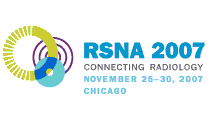
Abstract Archives of the RSNA, 2007
SSC20-02
Measuring Right Ventricular Volumes and Ejection Fraction with Simpsonís Method: Which MRI Axis Is Best?
Scientific Papers
Presented on November 26, 2007
Presented as part of SSC20: Cardiac (MR)
Michael Kemal Atalay MD, PhD, Presenter: Speaker, General Electric Company
David J. Grand MD, Abstract Co-Author: Nothing to Disclose
Kevin J. Chang MD, Abstract Co-Author: Nothing to Disclose
Jason Machan, Abstract Co-Author: Nothing to Disclose
Because of its complex morphology, accurate and reliable quantification of right ventricular (RV) volume and function using MRI is challenging. The aim of this study was to determine the interobserver reliability of RV volume and ejection fraction (EF%) calculated using Simpson’s method of slice summation applied to data acquired in three different orientations: transaxial (TA), short axis (SA), and parallel to the horizontal long axis (pHLA).
Twenty-four consecutive, consented patients referred for cardiac MRI were included in the study (10 males, 13 females; ave. age 43±19 yrs; ave. ht: 66±4 in; ave. wt: 177±51 lbs). Steady-state free precession was used to generate stacked, bright-blood cine loops in 3 separate, randomly ordered orientations: SA, TA, and pHLA. Slice thickness was 8 mm and slice separation 2 mm. Using Simpson’s method and pre-determined end-diastolic (ED) and end-systolic (ES) time points, three experienced radiologists independently measured RV ED and ES volumes and, in turn, EF% for each of the orientations. Data were analyzed using intraclass correlation.
A wide range of RV ED volumes and EF%’s were observed. Inter-rater reliability (IRR) of RV ED and ES volumes and EF% was determined for each of the axes. For the SA, IRR for all readers was 0.92, 0.87, and 0.33, respectively; for TA, 0.95, 0.90, and 0.71; for pHLA, 0.83, 0.91, and 0.67. (A higher ratio indicates greater reliability). For comparison, the same parameters were also determined for LV ED and ES volumes, and EF% measured using the SA: 0.98, 0.96, and 0.84. RV EF% determined by SA measurements was 5-6% lower than by both TA and pHLA (p<0.05), between which there was no significant difference.
Reliability of RV ED and ES volume measurements is comparable for all three axes evaluated. However, the reliability of the EF% is best on TA imaging. Our data suggest that for consistency, RV quantification should be conducted using the TA orientation.
RV volumes and global ejection fraction are important parameters for cardiac assessment. For consistency, quantification should be conducted using the transaxial orientation.
Atalay, M,
Grand, D,
Chang, K,
Machan, J,
Measuring Right Ventricular Volumes and Ejection Fraction with Simpsonís Method: Which MRI Axis Is Best?. Radiological Society of North America 2007 Scientific Assembly and Annual Meeting, November 25 - November 30, 2007 ,Chicago IL.
http://archive.rsna.org/2007/5003271.html

